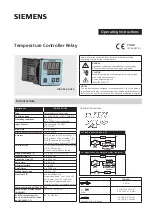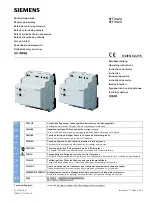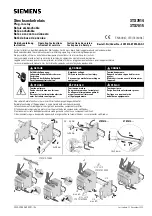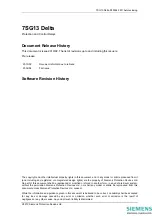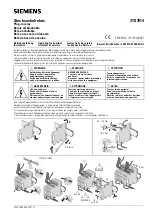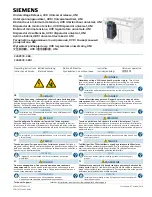
I.L. 40-386.3
2-8
(10/94)
AND-23; the output signal of AND-23 starts the 500/500 ms timer. The timer output
turns “ON” the non-memory LOI indicator, which is shown in the Metering mode, and
drops out the AL1 relay (Failure Alarm). If the LOI condition exists and
LOI Blk (LOIB)
is set at YES, the trip will be blocked after the 500 ms timer times out.
2.4.5
Fault Detector Overcurrent Supervision
For REL 301/302, as shown in
Figure 2-13
, the distance units do not require overcur-
rent supervision; because the relay normally operates in a background mode, they will
not start the Zone1 and pilot impedance computation until a phase current or a phase
voltage disturbance is detected. This approach can minimize the load problem when
setting the phase overcurrent units. However in order to meet the traditional practice,
a medium set phase overcurrent unit I
M
(any phase I
AM
, I
BM
, I
CM
) has been added (Ver-
sion 1.1) to supervise Zone1Ø, Zone2Ø, Zone3Ø and Pilot Øtrip functions, as shown
in
Figure 2-13
. This option should not be set to limit Zone3 reach, and traditionally
should be set above the load current.
For coordination purposes the ground trip units Zone1G
(Z1G), Zone2G (Z2G), Zone3G
(Z3G), Pilot G (PLTG)
, and
FDOG
are supervised by the medium set ground overcurrent
unit (IoM). The
Ios
setting and
RDOG
are used for carrier send in a Pilot Blocking sys-
tem.
2.4.6
Highset Overcurrent Trip
The instantaneous overcurrent units (IAH, IBH, ICH and IOH) are forward directional
and set high to detect those faults which occur in the Zone1, therefore, their tripping
will occur via OR-2 for HST, as shown in
Figure 2-14
. These high set trip functions can
be disabled by setting the
Inst Ø (ITP)
phase and/or
Inst G (ITG)
ground to the OUT po-
sition. The directional unit (Inst Ø and Inst G) will be automatically converted to non-
directional protection if the LOP condition occurs and the setting of LOP Blk = YES and
will be blocked if LOP Blk = ALL.
2.4.7
Close-Into-Fault Trip (CIFT)
There are three low voltage units (LVA, LVB and LVC) in REL 301/302. Each unit sens-
es the phase voltage condition in the background mode. The unit can be set from 40
to 60 volts, in 1.0 volt steps. For any phase voltage below its preset value, the LV logic
will produce a logic “1” output signal. The low voltage units are used in CIFT and weak-
feed logic in REL 301/302.
In order to supplement distance unit operation, when the circuit breaker is closed into
a fault and line side potential is used, the Close-Into-Fault Trip
(CIFT)
circuit operates
as shown in
Figure 2-15
. It includes logic AND-22 and 100/180 ms and 16/0 ms tim-
ers. If any overcurrent unit (IAL, IBL, ICL or IOM) operates OR-11, at the same time
as one of the phase voltages (VA, VB,VC) is below the preset level of the LV units, then
logic AND-22 is satisfied and produces a trip signal (for 180 ms) after circuit breaker
closes (52b contact opens). Tripping will be via OR-3,
(Figures 2-5, 2-6 and 2-7)
with
RB and
CIF Trip (CIF)
targets.
The application of “Close-into-fault” is selected by setting the value field of CIF Trip to
YES or NO.
Summary of Contents for REL 301
Page 1: ......
Page 8: ......
Page 17: ...I L 40 386 3 1 10 10 94 2682F39 Sheet 1 of 2 Sub 2 Figure 1 2 REL 301 302 Layout Vertical...
Page 18: ...I L 40 386 3 10 94 1 11 2682F39 Sheet 2 of 2 Sub 2 Figure 1 3 REL 301 302 Layout Horizontal...
Page 19: ......
Page 20: ......
Page 44: ......
Page 46: ......
Page 48: ......
Page 49: ......
Page 51: ......
Page 53: ......
Page 54: ......
Page 55: ......
Page 56: ......
Page 57: ......
Page 60: ......
Page 62: ...I L 40 386 3 10 94 2 41 Figure 2 32 CO 2 Curve Characteristics 619596 Sub 2...
Page 63: ...I L 40 386 3 2 42 10 94 Figure 2 33 CO 5 Curve Characteristic 619597 Sub 2...
Page 64: ...I L 40 386 3 10 94 2 43 Figure 2 34 CO 6 Curve Characteristic 619598 Sub 2...
Page 65: ...I L 40 386 3 2 44 10 94 Figure 2 35 CO 7 Curve Characteristic 619599 Sub 2...
Page 66: ...I L 40 386 3 10 94 2 45 Figure 2 36 CO 8 Curve Characteristic 619600 Sub 2...
Page 67: ...I L 40 386 3 2 46 10 94 Figure 2 37 CO 9 Curve Characteristic 619601 Sub 2...
Page 68: ...I L 40 386 3 10 94 2 47 Figure 2 38 CO 11 Curve Characteristic 619602 Sub 2...



































